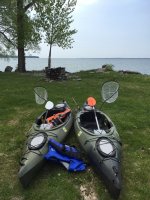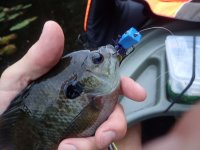For starting out with bass, I would keep your leader on the shorter end (7.5-8ft) and down to 0X or heavier tippet, and paired with top water fly patterns first (poppers, sliders, etc.) with weed guards. It can be frustrating having to paddle over and un-snag your flies repeatedly so having a short, stout leader and weed guards can help to pull flies through weedy areas. You'll also want a floating fly line that has a powerful front taper in order to turn over those air resistant bass flies.
Leech, streamer, and crawfish patterns are great to use along the seams between weed beds and more open water. Cast the fly right to where the weeds begin and strip it towards open water. Again, weed guards can help to prevent snags. The floating fly line works fine with this as well. As the season progresses, a sink tip line (or full sinking line depending on the depth of the lake you are fishing) can be more useful.
Lastly, I like to use popper-droppers when the action is slow. I'll cast a popper into more open water (along shallows, points, or even a large open spot amongst a weedy area) and have a nymph pattern suspended 1-3ft below it. This is also a good tactic to use if you plan on floating any smallmouth bass rivers.
For casting tips, the best advice I can give is to practice casting in the yard with your elbow on your knee. If you are right handed- Kneel on your left leg, place your casting elbow onto your right knee, and work on making smooth casts. This will help to reinforce the lesson that casting power is driven primarily at our elbow (the fulcrum). Practicing this will pay dividends when fly fishing from a kayak.





